2017-04-08 By Danny Lam
The top diplomats of both countries scripted the meeting between President Trump and Xi in order to avoid seemingly obvious problems that would obviously embarrass President Xi.
They wanted to avoid previous incidents such as when Fanlungong disrupted a press conference with President Hu Jintao and GW Bush and the anthem for Republic of China announced.
And so it was that such “gaffs” were avoided with the Trump-Xi visit.
nd Chinese President Xi Jinping walk together after their meetings at Mar-a-Lago in Florida. Photo: AP
What was very obvious is that no joint press conference (beside a photo opportunity) was held, no joint statement issued, and little of the normal congratulatory and laudatory statements normally conferred by heads of government on each other.
More awkward than the Trump-Trudeau summit that issued a joint statement that failed to mention Canada as an unrepentant defense free rider and steps to live up to Canadian commitments; or the missed opportunity for an on-camera handshake with Chancellor Merkel.
The most telling statement was when two Presidents arrived at about the same time, at opposite sides of the airport, and neither side took the opportunity to greet each other. Secretary Tillerson greeted President Xi’s arrival reminiscent of President Raul Castro’s snub of President Obama or Xi’s snubbing of Obama.
President Xi arrived in an Air China 747-400 that was removed from regular passenger service and converted with beds, sofas, etc. for the occasion. China, smarting from President Jiang Zemin’s purchase of a used American plane converted as Presidential transport in 2001 that was found seeded with listening devices, have satisficed with Air China passenger planes temporarily removed from service.
Not being a manufacturer of world class aircraft leaves China little choice but to utilize an aircraft that was clearly not properly equipped to defend itself against attacks, or to be a secure command post for Beijing China’s nuclear and conventional forces. Or to be free from “calling home” at anytime whether intentionally seeded with listening devices or not.
USS Porter Launches Strike Against Syrian Airfield
Contrast this with President Trump’s Air Force One that is well armed and defended against attacks, hardened against nuclear weapon effects, and capable of secure command and control of US Forces anywhere in the world in war or peace; and China’s status as an aspiring, rather than an actual superpower is clear. Future iterations of Air Force One will likely reinforce and strengthen this capability: making it clear that the POTUS dealing with their counterparts IS the one that holds the nuclear trigger.
It is not at all clear who, or what are the command and control linkages for Chinese nuclear and conventional forces when President Xi is away from China traveling on his vulnerable transports. Nor is it clear who is in charge if the President of China were to meet an untimely demise. President Xi exposed his government’s weakness for all to see.
Beijing China may be an economic superpower, but not a military superpower.
The visit was arranged at the behest of Beijing China.
While “China experts” derided President Elect Trump for his phone call with President Tsai of Taiwan after a less than cordial meeting with the PRC Ambassador and provocative missile barrage tests by PRC; the subsequent affirmation of “one China” by President Trump, it was clear that Trump did not expect the meeting to be friendly.
Beijing China, did, however, get the better of Secretary Tillerson on his visit, who failed to see the significance of using a Beijing drafted terms and speech when arranging the visit. Fortunately, when Beijing tried the same tactic on President Trump – offering to draft the joint statement – it was refused.
In any case, President Xi made the blunder of demanding and coming to a meeting with President Trump without prior-negotiations leading to substantial agreements to be concluded at the summit.
While such “get acquainted” meetings was fine with a President Elect as Prime Minister Abe did to build a relationship, it is not the way for heads of governments to meet only to have President Trump candidly proclaim “So far, I have gotten absolutely nothing” from Xi.
The other telltale of the visit was the absence of social gatherings where the leaders can interact with each other in informal settings, getting to know each other away from the aides, and for President Xi that came such a long way, a time for him to get over jet lag. In past visits, schedules over many days enabled President Xi to gradually get acclimatized and ready. The Trump-Xi summit, spread over about 24 hours, made for a tough occasion.
This was made more difficult by the refusal to permit the Xi delegation to stay at Mar-A-Lago: A privilege that Prime Minister Abe enjoyed.
The Beijing China diplomats tried to put a good face on it by alleging that they are concerned about being wiretapped at Mar-A-Lago and instead opted for Eau Palm Beach Resort and Spa about 8 miles from Mar-A-Lago.
But come on, if the US can wiretap Mar-A-Lago, they can do the same anywhere in the US.
The real reason Xi was barred was concern that Beijing agents will use it as an opportunity to plant bugs everywhere — making for an expensive (and potentially not through) clean up after their departure. It is also a clear signal of the distrust between the US and Beijing China that they are not allowed there overnight.
Staying at Eau Palm Beach just about assured that Xi’s motorcade will have to travel past anti Beijing demonstrators and protesters many times to and from the meeting — and that is what happened. It is not known if the US State Department picked up the cost of Xi’s delegation at Eau Palm as per custom. Trump personally paid for Abe’s visit to Mar-A-Lago while Abe’s staff stayed off site. If not, that be a major departure from protocol. Notably, there were few (if any) anti-Trump protesters.
While President Trump did not follow through on his threat to serve McDonald’s hamburgers, the dinner was decidedly average by Trump hospitality standards. PM Abe and his wife had an intimate dinner with the Trumps and Robert Kraft in an open, relaxed setting, the dinner with President Xi and his delegation was decidedly a working, formal, business meal attend by large delegations on both sides. In a clear snub, Trump, a non-drinker, served modestly priced wine.
No effort was made to impress Xi with hospitality.
The most telling moment was when President Trump informed President Xi of the Syrian missile strike at the end of the dinner — a decision he made 4 hours ago after 2 days of consultations.
Here is where the Beijing China was exposed as the paper tiger they really are. No aide interrupted the dinner to whisper to Xi about the attack before, during, or immediately after.
One is forced to conclude that either the Beijing China regime did not know, or their “allies” who did know like the Russians, Iranians, Syrians, etc. failed to warn them ahead of time or immediately after. Or that warnings were not efficiently conveyed to Xi and his delegation.
None of this reflects well on President Xi.
Russia was warned before the attack by the US, and other allies like Israel, Saudi Arabia, Turkey, UK, France, Canada, etc. were also briefed well beforehand.
Despite this widespread knowledge, Xi did not get told before the missiles struck. Russia, wisely, decided to accede to it despite their perfunctory protests ex poste facto.
Significantly, Russians did not tip off the Syrians to foil the attack.
What this exposed is Beijing China in fact do not have an effective worldwide real time intelligence gathering, interpretation and dissemination system on the ground, and an efficient means to communicate with their President on a vital matter at all times.
Contrast this with the North Korean missile test during the Trump-Abe dinner, when US and Japanese aides simultaneously rushed to alert their leader in full view of the public.
Given this performance, and the fact that President Xi travels in an unsecured fashion; Can we truly be sure that President Xi is in fact, and at all times, in full command and control of Beijing China’s nuclear and armed forces?
If Xi is not in full control of the armed forces? Just what is the chain of command in Beijing China?
This performance raises serious questions as to the structure of command and control, readiness and credibility of the PRC nuclear and conventional arsenal. It does not resemble what we know of the Soviet/Russian, US, French, and UK nuclear arsenal.
Beyond this, there is the question of precisely what ability Beijing has to project power much beyond their borders and littorals unless they resort to things like ballistic missiles or economic instruments. For all their prowess as cyber warriors, Beijing China was unable to detect on their own the launch of 59 cruise missiles off a hotly contested area of the Middle East. No PLAN units were nearby despite all their talk of “one belt, one road” and enhancing their Middle East presence. Russia can credibly threaten to block another US strike, Beijing China cannot. Nor can they defend sea lanes they depend on for trade.
President Trump’s Syrian strike did more.
American credibility was enhanced by how quickly Americans coalesced around the President with many “never Trumpers” muttering approval. Quarrelsome US allies, like Canada and Germany, abruptly shifted tact and approved with other allies.
Meanwhile, President Xi’s Beijing China was shown to be an impotent bystander who had no choice but to accept the fact despite their long stand stance that negotiations are the only solution to problems like Syria and North Korea. Indeed, North Korea deliberately provoked Trump and Xi just before the summit with another missile test: demonstrating Xi’s impotence.
On the other hand, America means it when President Trump say he will deal with North Korea with or without China. China exposed the rationale for their position favoring negotiations is because of their military impotency even with North Korea on their border. Perhaps Beijing China is deterred by the North Korean nuclear arsenal and their inability to militarily defeat it without risking a successful nuclear strike on China?
It sure looks that way.
Within 24 hours, President Trump unambiguously demonstrated to President Xi the attributes of a bona fide superpower: America did not ask for permission or consent from peer competitors like Russia or China. America was able to use force, and to do so legitimately and with the support of every major OECD nation to whom America is allied. No American allies, and even Russia, tipped off the Syrians.
Compare this with the lack of legitimacy when Russia and China used force both within and without their borders. Beijing China, in particular, has little legitimacy to their forceful sea grab campaign in the South China Sea, or their attempt to claim the Senkaku or Taiwan.
The limitations of President Xi and Beijing China’s power is exposed for all to see.
Militarily, China have little ability to project useable (conventional) military power more than a few hundred kilometers from their borders. Beijing China is ruling over a collection of very independent “local” governments who are trade and economic powers, but not military beyond their borders. Absent the use of nuclear weapons, or economic power, Beijing China is a paper tiger.
This perspective raises serious questions as to President Xi’s Beijing regime ability to militarily (or economically) compel North Korea to denuclearize.
It also raises doubts as to the willingness of Beijing to intervene militarily to prop up the Pyongyang regime — for such a campaign would leave Beijing China dangerously exposed to domestic revolt and rebellion.
President Xi’s visit exposed Beijing China’s dependence on the US and allies control of shipping lanes for the benefits of free trade. This is a relationship that Beijing China not only pays nothing for, but is actively disrupting and undermining with their military buildup against the US and allies.
There were some positive achievements out of the summit.
Xi and Trump setting up a dialog on four major issues: diplomacy / security, economic issues, cyber security and law enforcement, and finally, social / cultural issues is a foolish game. For it is a tacit acknowledgement that existing channels failed and is in need of what President Xi termed, a “new starting point”. Xi noted: “There are a thousand reasons to make Sino-US relationship work, and no reason to break it.”
These are hardly the terms one should use for one of the largest trading relationships in the world.
But it is the right term to deal with Beijing China’s oppressive and protectionist trading regime and the lack of credibility of Beijing commitments in trade.
Beijing China will be, for the first time, put on the spot by a tough minded Administration to deliver the goods and open their markets, or else. No doubt that Ivanka Trump will find the widespread ripoff and registration of her trademark and brand name in China to be unamusing. Beijing China’s failure to control the synthetic narcotics manufacture and export, like cyber security, are issues that cast doubt as to their actual power.
President Trump’s must do task in the summit is to size up and weigh the credibility and power of President Xi and his regime before he “make a deal” with them.
Toward that goal, President Trump performed brilliantly.


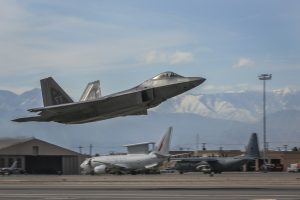 A United States Air Force (USAF) F-22A Raptor lifts off from the runway at Nellis Air Force Base during Exercise Red Flag 17-1. Visible in the background (from left) are a Draken International Inc L-159 Albatross; a Royal Australian Air Force (RAAF) E-7A Wedgetail, and a RAAF C-130J Hercules. Credit: RAAF
A United States Air Force (USAF) F-22A Raptor lifts off from the runway at Nellis Air Force Base during Exercise Red Flag 17-1. Visible in the background (from left) are a Draken International Inc L-159 Albatross; a Royal Australian Air Force (RAAF) E-7A Wedgetail, and a RAAF C-130J Hercules. Credit: RAAF


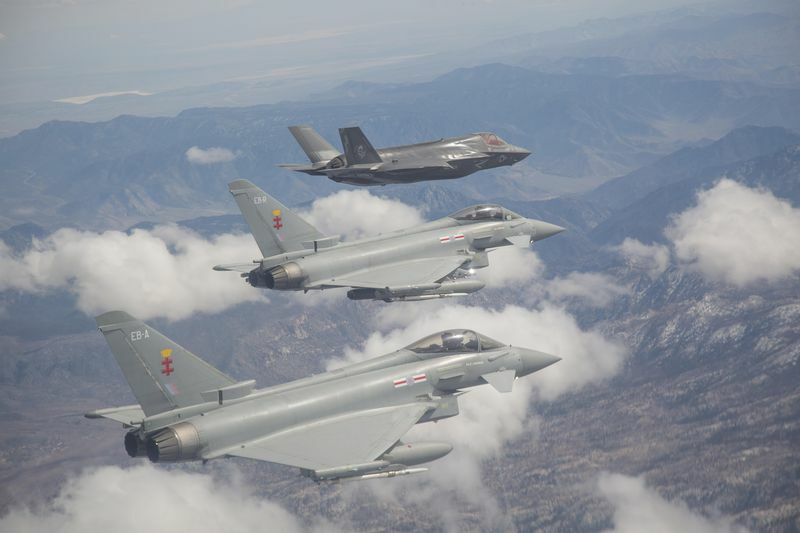
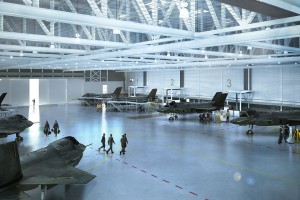 Computer Generated Image of the Maintenance and Finish Facility which is being built at RAF Marham, Norfolk, as part of a programme of works to prepare the station for the arrival of the F-35 Lightning II fleet in 2018.
Computer Generated Image of the Maintenance and Finish Facility which is being built at RAF Marham, Norfolk, as part of a programme of works to prepare the station for the arrival of the F-35 Lightning II fleet in 2018.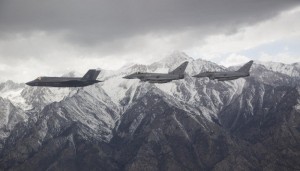 The F-35 Lightning II flew in formation with two Typhoons in April 2014.
The F-35 Lightning II flew in formation with two Typhoons in April 2014.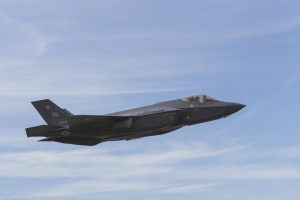 A United States Air Force (USAF) F-35A Lightning II (also known as the Joint Strike Fighter) climbs from the runway at Nellis Air Force Base during Exercise Red Flag 17-1. Credit: Royal Australian Air Force
A United States Air Force (USAF) F-35A Lightning II (also known as the Joint Strike Fighter) climbs from the runway at Nellis Air Force Base during Exercise Red Flag 17-1. Credit: Royal Australian Air Force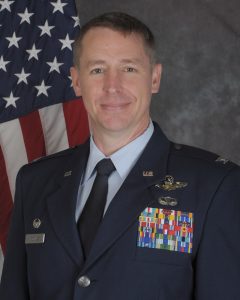 Col. Evan Pettus, the Commander of the 48th Fighter Wing at Royal Air Force Lakenheath, England.
Col. Evan Pettus, the Commander of the 48th Fighter Wing at Royal Air Force Lakenheath, England.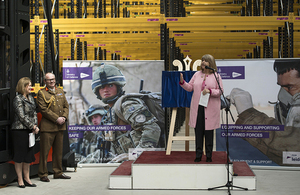 Harriett Baldwin (Min DP) and Chief of Materiel (Land) Lieutenant General Paul Jaques open the Defence Fulfillment Center in Donnington. This 80,000 fulfilment centre will be a step change in how we deliver defence inventory to our Armed Forces Globally.
Harriett Baldwin (Min DP) and Chief of Materiel (Land) Lieutenant General Paul Jaques open the Defence Fulfillment Center in Donnington. This 80,000 fulfilment centre will be a step change in how we deliver defence inventory to our Armed Forces Globally.